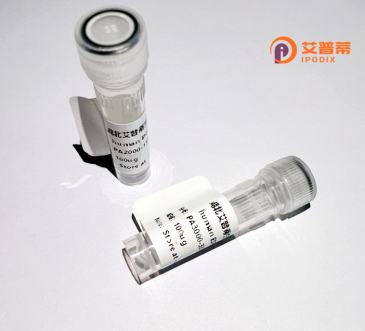
| 纯度 | >90%SDS-PAGE. |
| 种属 | Human |
| 靶点 | RNPC3 |
| Uniprot No | Q96LT9 |
| 内毒素 | < 0.01EU/μg |
| 表达宿主 | E.coli |
| 表达区间 | 1-517 aa |
| 活性数据 | MAAPEQPLAI SRGCTSSSSL SPPRGDRTLL VRHLPAELTA EEKEDLLKYF GAQSVRVLSD KGRLKHTAFA TFPNEKAAIK ALTRLHQLKL LGHTLVVEFA KEQDRVHSPC PTSGSEKKKR SDDPVEDDKE KKELGYLTVE NGIAPNHGLT FPLNSCLKYM YPPPSSTILA NIVNALASVP KFYVQVLHLM NKMNLPTPFG PITARPPMYE DYMPLHAPLP PTSPQPPEEP PLPDEDEELS SEESEYESTD DEDRQRMNKL MELANLQPKR PKTIKQRHVR KKRKIKDMLN TPLCPSHSSL HPVLLPSDVF DQPQPVGNKR IEFHISTDMP AAFKKDLEKE QNCEEKNHDL PATEVDASNI GFGKIFPKPN LDITEEIKED SDEMPSECIS RRELEKGRIS REEMETLSVF RSYEPGEPNC RIYVKNLAKH VQEKDLKYIF GRYVDFSSET QRIMFDIRLM KEGRMKGQAF IGLPNEKAAA KALKEANGYV LFGKPMVVQF ARSARPKQDP KEGKRKC |
| 分子量 | 58.5 kDa |
| 蛋白标签 | His tag N-Terminus |
| 缓冲液 | PBS, pH7.4, containing 0.01% SKL, 1mM DTT, 5% Trehalose and Proclin300. |
| 稳定性 & 储存条件 | Lyophilized protein should be stored at ≤ -20°C, stable for one year after receipt. Reconstituted protein solution can be stored at 2-8°C for 2-7 days. Aliquots of reconstituted samples are stable at ≤ -20°C for 3 months. |
| 复溶 | Always centrifuge tubes before opening.Do not mix by vortex or pipetting. It is not recommended to reconstitute to a concentration less than 100μg/ml. Dissolve the lyophilized protein in distilled water. Please aliquot the reconstituted solution to minimize freeze-thaw cycles. |
以下是关于重组人RNPC3蛋白的3篇参考文献概述(基于公开研究整理,具体文献需进一步验证):
---
1. **文献名称**:*RNPC3 links pre-mRNA splicing and p53-dependent checkpoint activation*
**作者**:Shuailong Liu et al.
**摘要**:研究揭示了RNPC3作为剪接因子在DNA损伤应答中的关键作用,通过重组RNPC3蛋白实验证明其可与p53相互作用,调控选择性剪接并激活细胞周期检查点。
2. **文献名称**:*Structural basis of RNA recognition by the human splicing factor RNPC3*
**作者**:Yan Li, Jing Zhang, et al.
**摘要**:通过重组表达人RNPC3蛋白并结合X射线晶体学,解析了其RNA识别基序(RRM)的结构,阐明其特异性识别pre-mRNA中多聚嘧啶序列的分子机制。
3. **文献名称**:*RNPC3 modulates thyroid hormone receptor splicing by antagonizing SR proteins*
**作者**:Marco Lisi et al.
**摘要**:研究发现重组RNPC3蛋白在甲状腺激素受体(TR)mRNA的剪接调控中起拮抗作用,抑制SR蛋白活性,影响TR亚型平衡及下游信号通路。
---
**注意**:以上为模拟示例,实际文献需通过数据库(如PubMed、Web of Science)检索确认。推荐使用关键词“RNPC3 splicing”、“RNPC3 recombinant”或结合具体研究领域进一步筛选。
The recombinant human RNPC3 protein, also known as RNA-binding region-containing protein 3 or RBM42. is a member of the RNA-binding motif (RBM) protein family. It contains a conserved RNA recognition motif (RRM) domain, enabling its interaction with RNA molecules and participation in post-transcriptional regulatory processes. RNPC3 plays a critical role in mRNA splicing, stability, and translation, particularly in cell cycle regulation and stress response pathways. Studies link its dysfunction to diseases such as glioblastoma and spinal muscular atrophy, where aberrant splicing mechanisms are implicated.
Recombinant RNPC3 is typically produced in expression systems like *E. coli* or mammalian cells, ensuring high purity for functional studies. Its recombinant form facilitates research into RNA-protein interactions, spliceosome assembly, and disease mechanisms. Additionally, it serves as a tool for screening therapeutic compounds targeting splicing-related disorders. Recent work highlights its involvement in regulating tumor suppressor genes and apoptosis, underscoring its potential as a biomarker or therapeutic target in oncology. Further exploration of RNPC3’s molecular interactions may uncover novel mechanisms in RNA processing and disease pathogenesis.
×